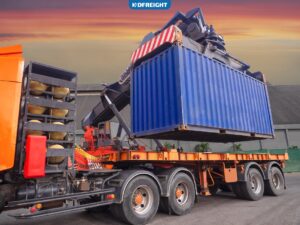This blog post will explore the ins and outs of shipping prefabricated buildings, uncovering the most effective methods, challenges to overcome, and best practices to ensure seamless delivery. Whether you’re a construction professional seeking to optimize your shipping process or an enthusiast intrigued by the possibilities, join us as we embark on a journey to discover the world of prefabricated building shipments and the success stories that inspire the future of construction. Let’s dive in!
Ready to revolutionize your shipping experience? Choose DFreight as your trusted digital freight forwarder. With our expertise in handling prefabricated building shipments and a global network of reliable partners, we ensure seamless transportation from the factory to the construction site. Say goodbye to shipping headaches and hello to efficiency, transparency, and cost-effectiveness. Contact us today to embark on a new era of hassle-free shipping with DFreight!
Table of Contents
Understanding the Concept of Prefabricated Buildings
Prefabricated buildings are constructed systematically, where skilled workers assemble components in specialized facilities using advanced machinery. This approach ensures high-quality and consistent results. The scope of prefabrication varies from individual components to complete building modules with integrated systems, making them versatile for various construction projects.
The benefits of prefabricated buildings include time efficiency, cost savings, enhanced quality control, flexibility in design, reduced disruption at the construction site, and sustainable practices. However, efficient shipping and transportation are crucial for the success of these buildings. Careful planning, coordination, and adherence to logistics are essential to ensure timely delivery and seamless assembly at the construction site.
Types of Prefabricated Buildings
- Modular Buildings: Modular construction involves creating individual building modules in a factory setting, which are then transported to the site and assembled to create the final structure. These modules can be stacked or arranged in various configurations, offering great flexibility in building design.
- Panelized Buildings: Panelized construction involves manufacturing large wall, roof, and floor panels in a factory. These panels are delivered to the site and assembled to create the building’s framework. Panelized construction is well-suited for projects with repetitive designs or where speed of construction is a priority.
- Pre-Cut Buildings: In this type of prefabrication, building components are pre-cut and prepared off-site, allowing for faster assembly at the construction location. Pre-cut buildings are often used for smaller structures like sheds, garages, and cabins.
- Container Buildings: Shipping containers are repurposed to create habitable spaces or structures. They offer portability, quick installation and can be stacked or modified for different configurations.

Preparing for Shipping
Shipping prefabricated buildings requires careful planning and preparation to ensure a smooth and successful process from the manufacturing facility to the construction site. Adequate site inspection, adherence to pre-shipment requirements, obtaining necessary permits, addressing legal considerations, and implementing proper packaging and protection measures are critical steps in preparing for shipping.
Site Inspection and Pre-Shipment Requirements
Site Readiness: Conduct a thorough inspection of the construction site to ensure it is ready to receive the prefabricated building modules. Verify that the site is properly leveled, has adequate access for delivery vehicles, and meets the specific requirements for the chosen prefabricated building type.
Accessibility: Ensure that no obstacles or hindrances might impede the movement of trucks or equipment during the delivery and unloading process.
Site Safety: Identify potential safety hazards and take necessary precautions to mitigate risks during the installation of the prefabricated building.
Measurement Verification: Double-check the dimensions of the modules and ensure they align with the site’s available space. Accurate measurements are essential to avoid any complications during assembly.
Permits and Legal Considerations
Transport Permits: Depending on the size and weight of the prefabricated building modules, certain transportation permits may be required from local authorities. Obtain these permits well in advance to avoid delays during shipping.
Route Planning: Plan the shipping route, considering any restrictions, road conditions, or limitations that could affect the transportation process.
Environmental Regulations: Comply with environmental regulations that pertain to the transport of prefabricated buildings, especially when crossing different regions or countries.
International Shipping: If the prefabricated building is being shipped across international borders, be aware of customs regulations, import/export requirements, and any taxes or duties that may apply.
Packaging and Protection Measures
Secure Packaging: Ensure that all prefabricated building modules are securely packaged to withstand the rigors of transportation. This includes proper wrapping, strapping, and reinforcement to prevent damage.
Weather Protection: Protect the modules from adverse weather conditions by using weatherproof covering and sealing vulnerable areas to prevent water ingress.
Labeling and Documentation: Clearly label each package with essential information, including module identification, handling instructions, and destination details. Prepare all required shipping documentation, including packing lists, invoices, and customs paperwork.
Impact Protection: Install impact-resistant materials within the packaging to cushion against shocks and vibrations that may occur during transit.
Insurance Coverage: Consider obtaining shipping insurance to safeguard against any potential damages or losses that may occur during shipping.
Shipping Partner Coordination: Coordinate with the chosen shipping company to ensure they are well informed about the requirements and handling procedures for the prefabricated building modules.
By adequately preparing for shipping, including conducting a site inspection, addressing pre-shipment requirements, obtaining necessary permits, and implementing proper packaging and protection measures, you can enhance the chances of a successful and problem-free transportation process. Taking these steps will contribute to the overall efficiency and safety of delivering the prefabricated building modules to the construction site, setting the stage for a smooth assembly and installation process.
Transportation Options
When shipping prefabricated buildings, choosing the right transportation method is crucial to ensure timely and secure delivery of the building modules from the manufacturing facility to the construction site. Different transportation options can be considered depending on the distance, size of modules, project timeline, and budget constraints. There are three primary transportation methods for shipping prefabricated buildings:
- Ground Transportation: Trucks and Trailers
- Sea Freight: Shipping Containers and Vessels
- Air Freight: Considerations and Limitations
Ground transportation is cost-effective and flexible for domestic shipments, while sea freight provides a global reach for international transport. Air freight is the fastest but expensive and has size restrictions. Proper planning and consideration of distance, budget, and project needs are essential to ensure successful and efficient delivery of building modules.
In conclusion, selecting the most appropriate transportation option for shipping prefabricated buildings requires careful evaluation of factors such as distance, time constraints, budget, and project requirements. Ground transportation, sea freight, and air freight each offer distinct advantages and limitations, making it essential to weigh these considerations to ensure the successful and efficient delivery of prefabricated building modules to the construction site.
International Shipping
Shipping prefabricated buildings across international borders involve navigating complex export and import regulations, customs clearance procedures, and addressing tax and duty considerations. International shipping requires meticulous planning and compliance with legal requirements to ensure a smooth and efficient transportation process.
Export and Import Regulations
Before shipping prefabricated buildings to another country, it’s essential to understand and comply with the countries’ export and import regulations where the modules are manufactured. Certain materials or technologies used in the construction may be subject to controls, and obtaining the necessary licenses is crucial to avoid legal issues.
Customs Clearance and Documentation
Commercial Invoice: Prepare a detailed commercial invoice that includes a description of the prefabricated building modules, their value, and any other relevant information required by customs authorities.
Bill of Lading: The bill of lading is a critical document issued by the shipping company, serving as evidence of the contract of carriage and receipt of the building modules. It contains information about the shipment and must be presented during customs clearance.
Packing List: Include a packing list that itemizes all the contents of the shipment, detailing the number of building modules, their dimensions, weight, and other pertinent details.
Certificates and Licenses: Some countries may require specific certificates or licenses for certain building materials or components. Ensure you have all the necessary documentation to comply with import regulations.
Importer of Record (IOR): The IOR handles customs clearance and import duties in the destination country. It can be the buyer, the recipient, or a designated customs broker. Choose the IOR carefully to avoid any issues during customs processing.
Dealing with Taxes and Duties
Import Duties: Importing prefabricated buildings into a foreign country typically attracts import duties and taxes the government levied on imported goods. The rates vary depending on the destination country and the classification of the prefabricated building.
Value Added Tax (VAT) and Goods and Services Tax (GST): Some countries impose VAT or GST on the value of the imported building modules. Check the applicable rates and ensure they are factored into the project’s budget.
Temporary Importation: In certain cases, temporary importation may be allowed for prefabricated buildings intended for specific projects. This allows for the modules to be brought into the country duty-free or with reduced tax rates, provided they are re-exported after the project’s completion.
Tax Exemptions or Incentives: Some countries offer tax exemptions or incentives for specific types of projects or for using prefabricated buildings in certain industries. Research whether your project qualifies for any such benefits.
In conclusion, international shipping of prefabricated buildings involves compliance with a range of export and import regulations, customs clearance requirements, and considerations for taxes and duties. By diligently preparing the required documentation and understanding the destination country’s import regulations, you can facilitate a seamless and successful transportation process while avoiding potential legal and logistical challenges. Working with experienced freight forwarders or customs brokers can also streamline the process and ensure a smooth transition from the manufacturing site to the construction location.
Working with Shipping Companies
Shipping prefabricated buildings involve collaborating with shipping companies specializing in transporting oversized or heavy cargo. Selecting the right shipping partner is crucial to ensure the safe and efficient delivery of building modules from the manufacturing facility to the construction site. Here are important considerations when working with shipping companies:
Evaluating Shipping Partners
Experience and Expertise: Look for shipping companies with experience in transporting prefabricated buildings. A company with expertise in handling oversized or specialized cargo will be better equipped to handle the unique challenges of shipping large building modules.
Reputation and Reviews: Research the reputation of the shipping companies you are considering. Check online reviews, testimonials, and feedback from previous clients to gauge their reliability and quality of service.
Equipment and Fleet: Ensure that the shipping company has the appropriate equipment, such as flatbed trucks, specialized trailers, or cargo vessels, to handle the size and weight of the prefabricated building modules.
Global Reach: If the project involves international shipping, verify that the shipping company has a global network and can transport the building modules to the desired destination.
Safety Measures: Inquire about the shipping safety protocols and track record. Safety is paramount when transporting large and valuable cargo like prefabricated buildings.
Understanding Shipping Costs and Quotes
Request Detailed Quotes: Obtain detailed shipping quotes from multiple companies, outlining all the costs involved, including transportation fees, packaging costs, customs duties, and any additional services required.
Transparency: Ensure that the shipping company is transparent about the breakdown of costs and clearly explains any additional charges or fees.
Delivery Timeline: Inquire about the estimated delivery timeline to determine whether it aligns with the project’s schedule and deadlines.
Special Services: If specialized services, such as crane assistance for unloading, are required, confirm that the shipping company can provide them and include the costs in the quote.
Cost-Benefit Analysis: While considering shipping costs, evaluate the benefits of timely and reliable delivery and the reputation and track record of the shipping company.
Insurance Coverage for Prefabricated Buildings
Cargo Insurance: Ensure that the shipping company offers comprehensive cargo insurance coverage for the prefabricated building modules. This insurance should protect against loss or damage during transit, providing peace of mind in case of unforeseen events.
Coverage Limits: Review the insurance policy to understand the coverage limits and any exclusions that may apply.
Additional Insurance: Depending on the value of the prefabricated building and the project’s specific requirements, consider obtaining additional insurance coverage to address any gaps in the shipping company’s standard policy.
Claims Process: Familiarize yourself with the claims process in case of loss or damage during shipping to ensure a smooth resolution if any issues arise.
By carefully evaluating shipping partners, understanding shipping costs and quotes, and securing adequate insurance coverage, you can mitigate risks and ensure a successful transportation process for prefabricated buildings. Working with reliable and experienced shipping companies enhances the likelihood of seamless and hassle-free delivery, contributing to the overall efficiency and success of the construction project.
Ship Prefabricated Buildings with DFreight: Efficiency at Your Fingertips!
As the construction landscape continues to evolve, prefabrication stands at the forefront, empowering us to construct buildings faster, more efficiently, and with greater sustainability. With each successful shipment, assembly, and utilization of prefabricated buildings, we move closer to a future where innovative construction practices revolutionize how we build, shaping a world of endless possibilities.
How are prefabricated buildings shipped?
Prefabricated buildings are shipped using various transportation options like ground transportation (trucks), sea freight (containers and vessels), and, in some cases, air freight.
What are the benefits of shipping prefabricated buildings?
Shipping prefabricated buildings offer advantages like reduced construction time, cost-effectiveness, controlled manufacturing conditions, and greater flexibility in design.
How are prefabricated building modules protected during shipping?
Building modules are protected through secure packaging, weatherproof covering, and impact-resistant materials to prevent damage during transit.
Can prefabricated buildings be shipped internationally?
Yes, prefabricated buildings can be shipped internationally, but it requires compliance with export and import regulations, customs clearance, and other legal considerations.
What is the typical lead time for shipping prefabricated buildings?
Lead times for shipping prefabricated buildings vary based on the shipping method, distance, and project-specific factors. Ground transportation may take a few days to weeks, while sea freight can take several weeks to reach international destinations.














